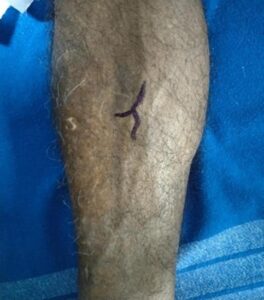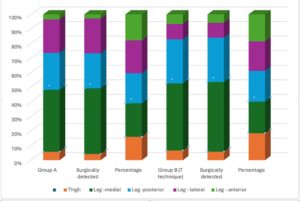Research Article | Vol. 6, Issue 1 | Journal of Surgery Research and Practice | Open Access |
Comparison of Routine Preoperative Doppler Marking of Incompetent Perforators and Sapheno Popliteal Junction with Standard T Technique
Jayalal JA1, Selwyn J Kumar2, Yuvaraj3, Ajin Daniel3, Haribaskar M4*
1HOD and Professor, Department of General Surgery, Kanyakumari Medical College, India
2Associate Professor, Department of General Surgery, Kanyakumari Medical College, India
3Assistant Professor, Department of General Surgery, Kanyakumari Medical College, India
4Postgraduate, Department of General Surgery, Kanyakumari Medical College, India
*Correspondence author: Haribaskar M, Postgraduate, Department of General Surgery, Kanyakumari Medical College, India; Email: [email protected]
Citation: Jayalal JA, et al. Comparison of Routine Preoperative Doppler Marking of Incompetent Perforators and Sapheno Popliteal Junction with Standard T Technique. J Surg Res Prac. 2025;6(1):1-6.
Copyright© 2025 by Jayalal JA, et al. All rights reserved. This is an open access article distributed under the terms of the Creative Commons Attribution License, which permits unrestricted use, distribution, and reproduction in any medium, provided the original author and source are credited.
| Received 25 December, 2024 | Accepted 20 January, 2025 | Published 28 January, 2025 |
Abstract
The study compares the two methods to determine which more accurately locates perforators, as confirmed by intraoperative findings. We included a prospective study with 50 consecutive patients who underwent varicose vein surgery in 2023 and 2024 for preoperative marking. The “T” approach uses Doppler marking to identify an inadequate perforator. The long limb of the T represents the superficial vein’s path, and the junction of the T indicates the perforator’s entry point into the deep fascia. Surgical correlation was done.
The “T” method of Doppler marking proved to be simple to use and beneficial for intraoperative identification.
In addition, it facilitated a more precise surgical approach, potentially leading to improved patient outcomes and reduced recurrence rates. Overall, the findings suggest that the “T” method may be a valuable tool in the preoperative assessment of varicose vein patients.
Keywords: Varicose Veins; Perforator; Doppler Marking
Introduction
Tortured, elongated, dilated superficial veins with visible reflux in standing posture are known as varicose veins. Varicose vein problems are quite prevalent in India, affecting an estimated 20-30% of the population, with women being particularly susceptible; factors like prolonged standing, obesity, and pregnancy are considered major contributors to this issue in the country.
While varicose veins can affect both genders, women are more likely to experience them due to hormonal changes during pregnancy and menstruation [1].
According to Western studies, it is a highly frequent issue that affects roughly 15% of males and 25% of women in the general population [2]. The condition not only leads to physical discomfort but can also significantly impact the quality of life. Early diagnosis and effective treatment options are crucial in managing varicose veins, as they can prevent complications such as venous ulcers and deep vein thrombosis. Jayalal JA, in their publication, stated that minimally invasive treatments are much more effective than the traditional surgical treatments for incompetent perforator veins. Jayalal JA’s, meta-analysis study concluded that endovenous RFA is a viable and effective alternative to surgery [3,4].
Despite spending a significant amount of time on surgery to address the issue, the recurrence rate remains unsatisfactorily high, and many patients receive insufficient preoperative investigation. When surgically treating varicose veins, the goal is to reduce the number of recurrent varicosities as much as possible by dividing and ligating all reflux sites from the deep to the superficial venous system, even if the perforators aren’t working well [5]. Despite the numerous contributing factors to postoperative recurrence, studies have identified two significant ones: inadequate surgery and inaccurate preoperative diagnosis of reflux locations [6].
An international consensus meeting was convened to consider the topic. The focus of the meeting was on veins, specifically the development of standardized protocols for the diagnosis and treatment of Recurrent Varicose Veins After Surgery (REVAS) [7]. This would enable healthcare providers to better address the complexities of this condition. cities of this condition. Experts from various countries shared their insights, emphasizing the importance of thorough preoperative assessments and meticulous surgical techniques to minimize the risk of recurrence.
Most people acknowledge the benefits of routine preoperative duplex screening before the initial procedure for varicose veins. Accurate reflux site diagnosis and suitable ligation reduce recurrence risk and achieve the best functional outcome. Clinically defining the location of incompetent perforators is challenging. Given these facts, there is a pressing need for a more objective method of detecting incompetent perforators. Color and spectrum Doppler is a valuable imaging tool before venous stripping and is capable of replacing invasive ascending and descending venography [8]. We have attempted to standardize the perforator marking on ultrasound with the T technique and correlate it with surgery.
Material and Methods
A prospective cohort study was carried out in the Departments of Radiology and Surgery between 2023 and 2024. The study included all patients scheduled for varicose vein surgery during this period. We divided them into two groups: Group A and Group B. Each group includes 25 patients. We marked Group A patients using the routine dot method. The dot indicates the junction of the superficial vein with the incompetent perforator, as well as the corresponding superficial point for the perforator’s entry into the deeper plane.
We marked the Group B patients using the T technique (Fig. 1). The longer limb of the T signifies the path of the dilated superficial vein, where the incompetent perforator joints are located. The length of these joints can range from 2 to 4 cm, and they don’t necessarily form a straight line. The intersection of the two limbs signifies the corresponding entry point for the perforator in the superficial vein [9].
Understanding the anatomy and positioning of these perforators is crucial for determining the most effective treatment strategies. Accurate identification of the entry points can significantly enhance surgical outcomes and minimize complications during procedures aimed at addressing venous insufficiency.

Figure 1: It is a photograph that shows T-shaped markings representing the site of the perforator.
Inclusion Criteria
- Patients between the ages of 18 and 60 years have been diagnosed with varicose veins and perforator incompetence
- Patients consented to inclusion in the study
- The study also required that participants had not undergone any previous surgical interventions for varicose veins or related conditions
Exclusion Criteria
- Patients under the age of 18 are eligible
- Patients did not provide consent for inclusion in the study
- Patients with DVT and history of DVTN Additionally
- To ensure a homogeneous study population, we excluded individuals with significant comorbidities that could affect healing or recovery
Results
The study included 50 patients who underwent surgery for varicose veins. The study included 40 men and 10 women, ranging in age from 18 to 60 years old, with an average age of 37 years. The majority of patients reported improvement in symptoms post-surgery, with 80% experiencing complete resolution of pain and discomfort. Follow-up assessments at three and six months indicated sustained satisfaction with the surgical outcomes, highlighting the efficacy of the intervention in this specific population. Table 1 displays the distribution of reflux, revealing SFJ incompetence in 42 out of 50 patients and Sapheno Popliteal Junction (SPJ) incompetence in 10 limbs (Fig. 2,3, Table 1-3).
Site of Incompetence | Number (%) |
SFJ | 42(84%) |
SPJ | 10 (20%) |
Perforators | 49(98%) |
Table 1: Distribution of incompetence.
Location | Number |
Thigh | 10 |
Leg – medial | 72 |
Leg – posterior | 45 |
Leg – lateral | 28 |
Leg -anterior | 8 |
Table 2: Displays the distribution of the perforator.

Figure 2: Distribution of perforators.
Detection rate for perforators using the dot method was relatively low, 71/87 (81.60%), compared to the T technique, 69/76 (90.78%).
Location of perforator | Group A (Dot method) | Surgically detected | Percentage | Group B (T technique) | Surgically detected | Percentage |
Thigh | 5 | 3 | 60% | 5 | 4 | 80% |
Leg -medial | 37 | 32 | 86.4% | 35 | 33 | 94% |
Leg -posterior | 22 | 17 | 77.2% | 23 | 21 | 91.3% |
Leg – lateral | 20 | 17 | 85% | 8 | 7 | 87.5% |
Leg – anterior | 3 | 2 | 66.6% | 5 | 4 | 80% |
Table 3: Displays the surgical detection rate of various perforators.

Figure 3: Surgical detection rate of various perforators.
We detected Sapheno Popliteal Junction incompetence in 10 limbs (20%). The detection rate for SPJ incompetence was 100% (10/10 in 50 limbs. The Doppler sonography marks on the Sapheno-Popliteal Junction were also correct, which helped with the surgery to connect the SPJ.
Discussion
Two common surgical methods for incompetent perforator ligation, Linton’s subfacial and Cockett’s extra-facial, rely on large incisions and assume a specific distribution of perforators. Despite the common distribution of perforators in some locations, we found that they occur in different locations, making Doppler detection crucial for a more satisfactory outcome. We found that by identifying the perforators prior to surgery, we can minimize incisions to the precise location, potentially leading to superior functional results, as Doppler testing covers the entire lower limb surface region.
Another preoperative imaging technique for identifying perforators is contrast venography, which provides detailed visualization of venous structures. This method, while more invasive than Doppler ultrasound, can offer additional insights into the vascular anatomy, enabling surgeons to plan their approach more effectively and improve surgical outcomes. There are times when non-invasive imaging doesn’t give enough information. This is especially true for patients with complicated vein anatomy or when there is a suspicion of a venous occlusion. In such situations, contrast venography can help delineate the anatomy of the perforators and assist in the selection of appropriate surgical techniques. However, its use is uncommon, and it has several drawbacks, including invasiveness. Doppler has the following benefits: it is non-invasive, cross-checkable, reproducible, doesn’t require ionizing radiation, and doesn’t obstruct any perforators like phlebography does. Additionally, Doppler ultrasound can provide real-time visualization of blood flow, enabling clinicians to assess both venous and arterial conditions effectively. This makes it a valuable tool for monitoring the success of treatment interventions and guiding future management strategies. The ability of Doppler testing to assess the perforators under physiological distension (standing, non-weight bearing) is another point we want to emphasize. This makes it particularly advantageous for evaluating venous function in patients with chronic venous insufficiency. Furthermore, Doppler’s real-time feedback enables immediate assessment and adjustment of treatment plans according to each patient’s unique vascular response.
Clinically defining the locations of perforators is challenging due to their variability and the complex anatomy of the venous system. However, advancements in imaging techniques, such as high-resolution ultrasound, have improved our ability to accurately identify and assess these critical areas, which is essential for tailoring effective interventions.
It is crucial to split and ligate each perforator to decrease the frequency of recurrent varicosities and to enhance overall treatment outcomes. Careful mapping of these perforators can also help surgeons decide how to do their work, making sure that they only affect the problematic veins and leave the healthy ones alone. This approach not only minimizes unnecessary tissue damage but also improves patient recovery times and satisfaction. Ultimately, the integration of advanced imaging techniques into surgical planning represents a significant advancement in the treatment of venous insufficiency.
A comparison between Doppler identification and surgical detection of perforators indicates that it is a step toward the best care for individuals with varicose veins. We can evaluate the long-term advantages by measuring the recurrence rate and comparing it to the rates without Doppler labeling for perforators. Doppler detection of incompetent perforators in patients with varicose vein disease is the best noninvasive technique available to detect the number and distribution of the incompetent perforators. The main aims are to obtain a better surgical outcome, reduce the recurrence, and achieve a cosmetically better result. We have attempted to standardize the method of perforator marking using the Doppler technique, and the preliminary results are encouraging.
Conclusion
The implementation of this standardized Doppler technique can significantly enhance preoperative planning and improve overall patient satisfaction. In terms of preoperative marking, our research has demonstrated that the T method of marking allows for accurate identification of the perforators on the surgical table, thereby preventing extensive dissection, which is the primary cause of regrowth and recurrence. This approach not only streamlines the surgical process but also minimizes potential complications associated with excessive tissue manipulation. Ultimately, by refining our preoperative strategies, we can foster better surgical outcomes and contribute to the long-term success of our patients. Future studies will be essential to further validate these findings and refine the technique for broader clinical application.
Conflict of Interest
The authors declare that there is no conflict of interest.
Funding
This research received no specific grant from any funding agency, commercial or not-for profit sectors.
References
- Houghton AD, Panayiotopoulos Y, Taylor PR. Practical management of primary varicose veins. Br J Clin Pract. 1996;50 (2):103-5.
- Callam MJ. Epidemiology of varicose veins. Br J Surg. 1994;81 (2):167-73.
- Jayalal JA. Meta analysis and systematic review of radio frequency ablation vs Trendelenberg surgery for varicose veins, Int J Science and Research (IJSR). 2024;13(9).
- Jayalal, J.A., et al, effect of stab avulsion, sclerotherapy, sub fascial ligations on below knee perforator incompetence. Int J Med Pub Health. 2025;14(2).
- Raju S, LeonelVillavicecio J. Surgical management of venous disease. Williams and Wilkins. USA. 1997;275.
- Rivlin S. The surgical cure of primary varicose veins. Br J Surg. 1975;62:913-17.
- Perrin MR. Recurrent Varices After Surgery (REVAS), a consensus document. REVAS group. Cardiovasc Surg. 2000;8(4):233-45.
- Magnusson M, Kalebo P, Lukes P, Sivertsson R, Risberg B. Colour Doppler ultrasound in diagnosing venous insufficiency-a comparison to descending phlebography. Eur J Vasc Endovasc Surg. 1995;9(4):437-43.
- Aparna I. Standardisation of preoperative marking of incompetent perforators and sapheno popliteal junction on doppler with evaluation of “T” technique. Ind J Surg. 2011.
Author Info
Jayalal JA1, Selwyn J Kumar2, Yuvaraj3, Ajin Daniel3, Haribaskar M4*
1HOD and Professor, Department of General Surgery, Kanyakumari Medical College, India
2Associate Professor, Department of General Surgery, Kanyakumari Medical College, India
3Assistant Professor, Department of General Surgery, Kanyakumari Medical College, India
4Postgraduate, Department of General Surgery, Kanyakumari Medical College, India
*Correspondence author: Haribaskar M, Postgraduate, Department of General Surgery, Kanyakumari Medical College, India; Email: [email protected]
Copyright
Jayalal JA1, Selwyn J Kumar2, Yuvaraj3, Ajin Daniel3, Haribaskar M4*
1HOD and Professor, Department of General Surgery, Kanyakumari Medical College, India
2Associate Professor, Department of General Surgery, Kanyakumari Medical College, India
3Assistant Professor, Department of General Surgery, Kanyakumari Medical College, India
4Postgraduate, Department of General Surgery, Kanyakumari Medical College, India
*Correspondence author: Haribaskar M, Postgraduate, Department of General Surgery, Kanyakumari Medical College, India; Email: [email protected]
Copyright© 2025 by Jayalal JA, et al. All rights reserved. This is an open access article distributed under the terms of the Creative Commons Attribution License, which permits unrestricted use, distribution, and reproduction in any medium, provided the original author and source are credited.
Citation
Citation: Jayalal JA, et al. Comparison of Routine Preoperative Doppler Marking of Incompetent Perforators and Sapheno Popliteal Junction with Standard T Technique. J Surg Res Prac. 2025;6(1):1-6.



